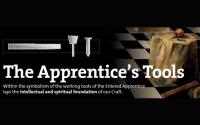The Apprentice’s Tools
28 March 24
The Apprentice’s Tools Within the symbolism of the working tools of the Entered Apprentice lays the intellectual and spiritual foundation of our Craft.
The symbolism of these tools has evolved in ages past when, in the absence of written language, lessons were taught and transferred by relating important messages to the elementary tools used in everyday life. The 24-inch gauge, the common gavel and chisel were such tools from which teachings of conduct and morality are believed to have evolved.
The essential truth and relevance of these lessons has persisted over time and, in recent centuries, become an integral part of the fabric of our masonic ritual.
The 24-inch gauge was the earliest instrument of measurement from which both distance and time were determined the 12 hours of the day and the 12 hours of the night. The lesson from this division of time was that it must not be wasted, it cannot be evaded and it must be used to best advantage in achieving the ultimate purposes of Life. Thus the 24-inch gauge symbolises the objective use of our private time – and how we appropriate and apportion time between our daily duties of work, prayer, meditation and rest.
The 24-inch gauge exemplifies our threefold duty – to God, to our neighbours and ourselves, which are incumbent upon every brother every day. It allocates no definite apportionment of time but tells us in clear language how each day should be occupied.
It exhorts us to go forth in prayer to our labour and service until evening. Prayer is a matter of attitude, and the man ‘who in times of difficulty and danger puts his hand into the hand of God’ enunciates his prayer of Faith.
The common gavel is the simplest of all tools, the origin of which goes back to primitive man, evidence of which is found in virtually all parts of the world. The wedge shape of the gavel is the first principle of mechanics and is even now an essential component of even the most complicated modern machinery. It is an essential tool in common use in modern life.
Symbolically, it represents the force of conscience. It dictates our individual responsibility for our actions, the appropriate line of action to be done or not, the choice of right or wrong and that the onus of our decisions as individuals clearly rests with us.
Conscience can be said to assume a judicial attitude which commands when our actions are right but condemns when our actions are wrong. We are endowed with the privilege of self-government and self-determination. Conscience should also regulate our conduct with regard to our neighbours in civil, social and other functions of modern life. Conscience is purely moral; it is the knowledge of one’s actions and knowing what is right.
In our ritual we are admonished to examine and respect our character. It teaches us to ‘correct the errors and irregularities of our temper, to curb the aspirations of unbridled ambition, to moderate the outbursts of wrath (or anger) and repress the malignancy of envy, to condemn the excrescences of vice’. Unbecoming thoughts and actions unworthy of a Freemason must be cast aside as worthless to avoid offending the Great Architect.
The chisel differs from the 24-inch gauge and the common mallet in two essential respects. Firstly, its efficiency as a tool is not contained within itself, it requires an independent force – a heavy gavel – to be used successfully.
Secondly, it must be maintained sharp to be an efficient tool. It demands significant but subtle skill on the part of the Craftsman to enable him to finish and polish his work. It symbolises the role of education as a vital and necessary tool for properly training and equipping a man as a useful productive member of society.
Our ritual explicitly defines that the chisel represents the advantages of discipline and education, which further develops the intellectual potential of each person into a civilised and enlightened being capable of appreciating and performing our duty to man and to God.
In practical terms, the symbolic intention of the chisel is to motivate each new candidate to devote himself to the continual process of learning, to know, to understand and to appreciate the many and complex elements that constitute modern society; in particular the contemporary environment in which he lives and is now obligated to make a useful contribution. This includes the progressive acquisition of masonic knowledge through learning and appreciating our brilliant ritual and by readings from the literature on Free masonry available in the Sydney Masonic Library.
Together, the symbolic teachings of these three simple elementary tools unquestionably represents the most relevant and pertinent foundation for teaching civilised and thoughtful conduct in an educated society. No other philosophy or moral doctrine is more expressive or relevant in its objective of promoting those human values that give meaning and expression to the nobler and more democratic values of Life.
As appeared in the Summer of 2011, Freemason Magazine


